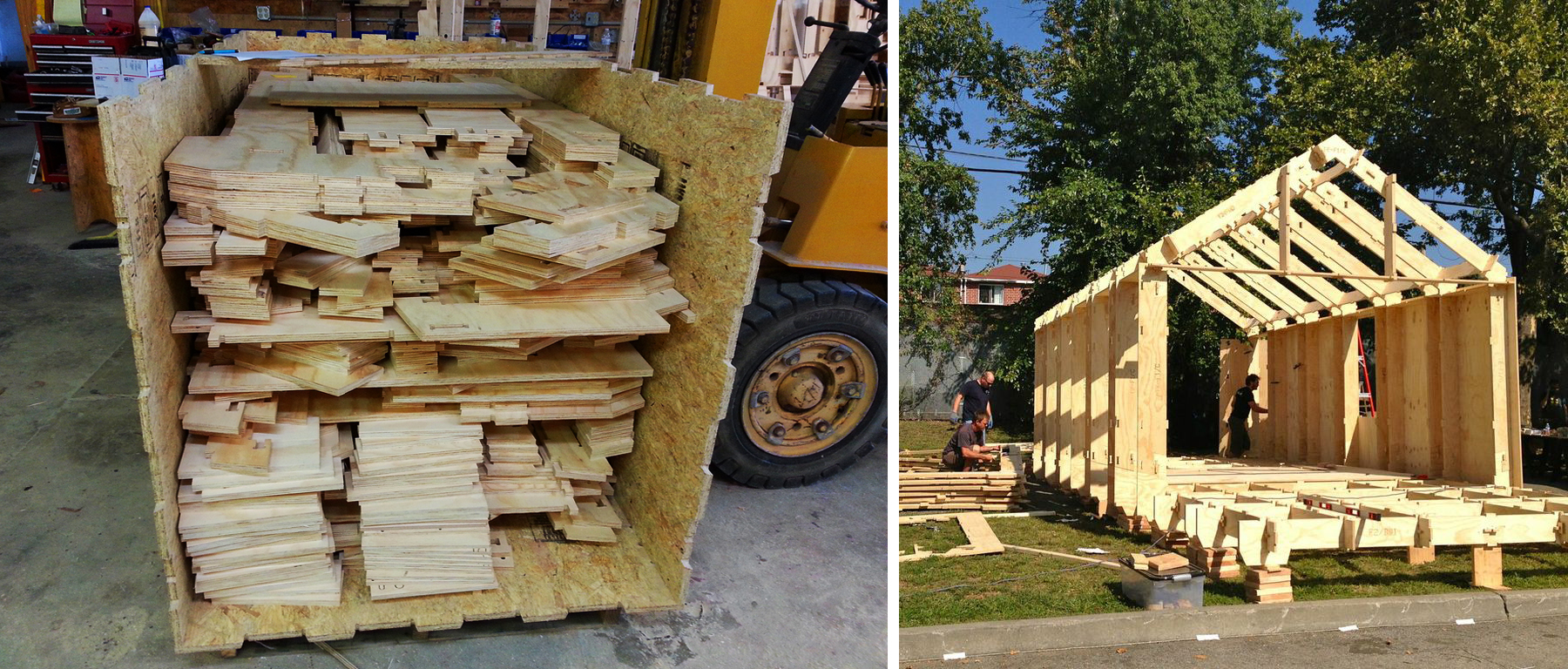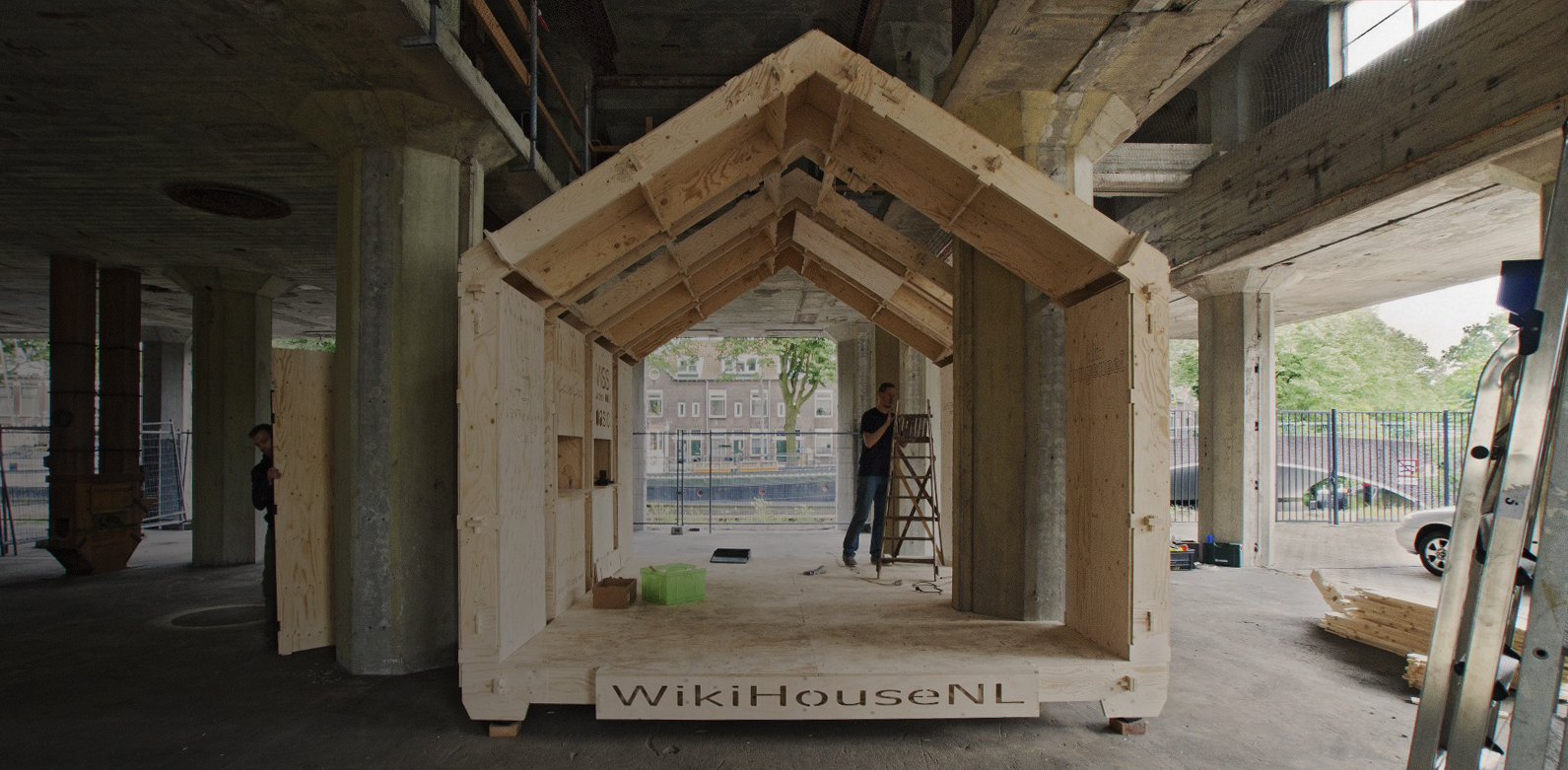Architects: Showcase your next project through Architizer and sign up for our inspirational newsletter.
During the 2015 edition of the London Design Festival, UK architecture firm 00 (pronounced “zero zero”) took over The Building Centre’s lawn and erected Wikihouse. An architectural experiment in digital DIY, it’s an open-source set of online blueprints that can be downloaded, CNC-milled, and like a large-scale, 3D jigsaw puzzle, erected by “a team of amateurs” in as quickly as a day.
Fast forward to 2019, and this pioneering project is alive and well: the latest iteration of the WikiHouse is free to download, including .dxf files, a Sketchup model and a comprehensive construction manual to make Ikea aficionados weep. This most up-to-date design is dubbed the Microhouse — a “high-performance, one-bed house type” using the WREN construction system and structural-grade plywood materials.

Wikihouse “Microhouse” template
What urban issues catalyzed the WikiHouse project? In London, it’s a question of demand outpacing supply: The city needs to build 800,000 new homes over the next decade, according to projections by London Councils, but only 25,000 annually are slated for construction. Elsewhere, cities are suffering an explosion in rent: San Francisco rates rose 13.5 percent in 2014 alone. In Brooklyn, an affordable housing complex with 38 units received 70,000 applications.
The architectural community’s solutions have included micro-mini units and prefabricated modules, but WikiHouse is one of the few to propose letting people download and build their homes themselves, in addition to uploading their own designs. Open-source, online architecture seems to be a logical step, given the way that Internet self-publishing is already ubiquitous in literature, music, design, and film.
“We saw this future playing out where the web and digital manufacturing combine,” explained 00 principal Alastair Parvin. “It’s been given a name, the ‘third industrial revolution,’ by Jeremy Rifkin.”

00’s team flew across to Queens in New York to build a WikiHouse for World Maker Faire 2013
The use of the word “revolution” and reference to an industrial theorist highlights how this project tackles the issue of affordable housing politically as much as it does structurally. In 2012, Parvin actually published (independently, online, for you to download and read for free) “A Right to Build,” a treatise on how “self-build” can put an end to the UK’s housing crisis, of which Wikihouse is a physical manifestation.
But how viable is it really to build a community downloaded from the Internet? Parvin spoke to Architizer back in 2015 about the logistics of the project and where exactly Wikihouse fits into the revolution.
Architizer: Your book, “A Right to Build” was an investigation into the UK housing crisis. What conclusions did you come to?
Alastair Parvin: One of the reasons why I became interested in the housing crisis is that it’s happening in countries like America or Britain. They are some of the wealthiest nations on earth, and yet in Britain we are building some of the smallest houses, or the second-smallest houses in Europe. Why do we have a housing crisis when we are supposed to be wealthy?
Since the industrial Revolution, the assumption has basically been that the only people who can produce quality stuff in an effective way are massive organizations and corporations, whether that was the market or the state. When we talk about the housing crisis, which we know in the UK is primarily a crisis of land and infrastructure that leads to massive inflation, you’ve still got governments going, “Oh, let’s get more land for the house building companies, the developers.” And they won’t use it, because they have fundamentally misunderstood their business model.
A developer will only build when it is profitable to do so, so even if we gave them loads of land, they would still only release houses on to the market at the speed that keeps prices high. Custom builders do not build only when it is profitable. They build when they want a house, which is all the time. So, the heart of this whole thing is that question: Who builds our homes? The assumption is that it must be these big or organizations, and what we’re arguing is that these new technologies that is no longer the case.

Erecting the WikiHouse jigsaw puzzle; via the Building Centre
It sounds like a mission to democratize architecture for the masses. But when you remove architects from the equation, aren’t people left with just buildings? Does the system actually deprive people of architecture, of the expressiveness of it?
Personally, I reject your distinction between architecture and buildings. This idea that somehow architecture should celebrate itself as rarified art is rubbish. What we want to do is allow architects the ability to think creatively and constructively about design, and to diffuse that to more people, to reconnect users and good design in a much more expanded marketplace.
Certainly something like WikiHouse is a system, like Lego. It’s a set of rules, but within those rules you can design almost anything. The great thing about open source is that if you want to take the design and improve it, or do something new with it, you can. I’m excited to see what people will do with it. Some people will design for themselves, but most people will probably go to an architect whom they couldn’t afford for the six months or whatever it requires to do a kind of grand design. But they could afford to hire an architect for a few weeks, or a few days even.
You could go to an architect and say “design me a house, but design me a house from this system that I know is going to work.” The architect can spend less time worrying about if he is going to get through building regulations or is it going to leak, and he can spend more time on what you call those expressive or personal aspects of design and really understand the end user. Architects and the world in general have a huge amount to gain giving the end user, the citizens, more power to procure and design architecture.
So you don’t envision a WikiHouse future of cookie-cutter houses?
No, it’s the opposite. They are literally made by a very specific cookie cutter, but the point is that you can now have customized and bespoke at the same price as you could have something identical. Everyone is so used to this world where housing is made by a single company that produces hundreds of homes for this imaginary average person. It makes much more sense to do it the other way around.
If I get a technology that can prefabricate a house at twice the speed at half the cost of an ordinary house, and give that to a developer, they are still going to sell the house at the same price that in that area, whereas if you put that same technology into the hands of the end user, you can get a better, cheaper house. The only person who has a real direct incentive to put more insulation in the walls, or whatever it might be to really attend to the quality and sustainability of that home, is the person who is going to be living there and paying the heating bills.

The WikiHouse is designed to be customized by each user to create forms that fit their needs; via WikiHouse
Where does WikiHouse fit with existing architecture — in the literal, physical sense? Where do you put them? Will they be in an areas that are designated for WikiHouses?
Well, they might be. The great thing about open-source is that you don’t know all the uses that people mind find. WikiHouse is a growing platform with a variety of technologies. Not just CNC-cut structures, but now its got ventilators, plug-and-play services, off-grid energy, and things like that. It’s going to be an increasing range of construction technologies, not just one.
One immediate use that some people will find is for small micro-houses built in their garden and extensions to their homes. Because it’s very lightweight and can be flatpacked, I imagine people will start developing designs to be built on a rooftop to densify existing buildings. London I think is particularly a strong candidate, unlike New York, where a lot of the rooftops have really been mined out to make roof gardens or whatever.
When you describe that, it sounds like a one-unit-at-a-time solution, yet you use the word “density.” Can you impact a shortage of housing if you build one-by-one?
We did a little calculation on what the housing shortage was in the UK. We worked out that we could build the number of homes that we need either if we made huge cities, or alternatively, if every street in Britain added one house. There is no reason that this technology can’t be used in groups to make a whole neighborhood, and I think it will quite soon. You will see groups come together and make a community facility or a central building first, which has the CNC machine in it. Then that machine cuts the homes on site.
When you describe these WikiHouse communities, do you imagine who lives there? In my mind it can go in two ways: It can become a class marker, where you have affordable housing that those type of people live in, or it’s populated by DIY hipsters. Do you think there will be a time when it can enter the mainstream?
That’s my objective. At the moment people have these two categories in their mind: Attractive, interesting architecture for rich people and one-size-fits-all boxes for poor people. It doesn’t stack up. Everyone needs a home. We want to develop technologies that are affordable, but that everyone can look at and go, “That’s beautifully designed.” One of the things about open-source is that you don’t design for other people in other countries whom you don’t understand and whose economies you don’t know. You design to solve the problem where you are and then share the solution. Share globally, build locally.
An immediate base for WikiHouse are those people who aren’t super wealthy, but are also not super poor. You have to be really rich before you’re not screwed by the current housing crisis in the UK.

Additional components like insulation, plumbing and electrical outlets come together to create a useable home; via WikiHouse
That structure that was in the lawn of the building center — how far or how close is that to being a viable thing for people to just start using?
Well the structure is there, but the first caveat is that our web platform needs development. That’s what we are going to be working on. Secondly, getting a system through building regulations is quite doable, but what tends to be a bit slower are mortgage providers and warranty providers. They tend to be more conservative when it comes to innovative technologies. So it will be another cycle, or a year or so before mortgage providers will recognize that the system works, that the technology is there, for the web platform to catch up. In a way, it’s really not so innovative. It’s just vernacular with an Internet connection.
On that last note: The Internet has provided people an extraordinary ability to publish whatever they want, which results in a lot of self-professed curators and authors and journalists. Are people now going to be under the illusion that they are architects?
It’s a functional illusion I have no problem with. I can’t say that people won’t make daft bits of design — I love the fact that people might make something ugly — but I am more interested in people than design.
To download your own WikiHouse construction kit, click here.
Architects: Showcase your next project through Architizer and sign up for our inspirational newsletter.









